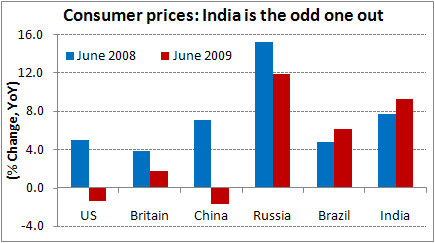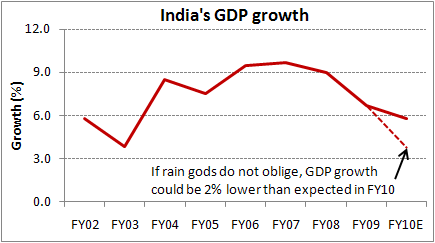It's official: India is in a drought
In this issue:
» US$ 39 bn to be mopped up in stake sale
» India suffers due to poor customer service
» Impact of poor monsoons on monetary policy
» Employment market in the US remains weak
» ...and more!!
---------- Only till the 19th of August... -----------
We've uncovered a new opportunity in the MidCap segment... and you don't want to miss this. We believe this company's stock has the potential to multiply your money 3 times in 3 to 4 years. Full details about this opportunity will be revealed in our report to be released at 5 PM IST on the 19th of August.
Sign up today and be among the first to get this report!
----------------------------------------------------
| 00:00 |
 |
|
To make matters worse, there are indications that monsoons may even withdraw earlier in mid-September instead of early October, thus affecting the Rabi crop as well. Needless to say, a significant damage has already been done to the Kharif crop.
As far as the damage of poor rainfall on the economy is concerned, these seem to be early days yet to make any meaningful estimates. Fortunately, things don't seem as bad as they were during the drought of 2002. For one, we are having a large buffer stock of wheat and rice that may help in curbing runaway prices and secondly, with the government running many pro-poor schemes like the NREGS (National Rural Employment Guarantee Scheme), damage to an average farmer's income could also be minimised. Even some well known economists are not willing to downgrade India's growth just yet. Having said that, the CMIE has reduced its forecast for India's GDP growth from 6.6% to 5.8% for the current year. We second that view and believe that the drought that India is facing will certainly have a negative bearing on economic growth this year.
| 00:57 |
Chart of the day |
However, India and Brazil seem to be an exception to this trend. In fact, India's consumer prices have refused to retreat even though the economic slowdown pushed the wholesale price index (WPI) into the red. What is more, the deficient monsoon and the resultant hindrance to crop production mean that consumer prices are not likely to abate anytime soon.

|
| 01:56 |
 |
|

|
| 02:21 |
 |
|
As per reports, the average public float in Indian listed companies is less than 15% currently, making them vulnerable to manipulation, scams and abuse by majority shareholders. Hence, raising the limit to 25% will not only reduce the odds of an abuse considerably it will also bring Indian regulations at par with markets like the US, UK and Hong Kong. Incidentally, the top 10 companies that may have to sell stakes are the PSUs accounting for a significant 80% of the total value to be offloaded. Currently, the proposal is in the process of seeking public comment on a government website with the Government planning to take up the issue after completing 100 days in office.
| 03:11 |
 |
|
India together with Australia and New Zealand, the other two countries being surveyed, stand to lose a total of Rs 280 bn in abandoned transactions and customer churning. Having to repeat information again and again, long waits, random call transfers and poorly-trained customer service executives do no good to appease the annoyed customer. We believe it is high time that companies start investing in high-end technology to improve Indian customer service which is nowhere close to its developed counterparts.
| 03:43 |
 |
|
| 04:14 |
 |
|
She has a point. After all, given the kind of shock that US consumers have received since the eruption of the crisis on their wealth and job prospects, one can hardly expect them to revert back to their binging days so that the US economy logs in a robust GDP growth!
| 04:43 |
 |
|
| 04:55 |
Today's investing mantra |
Today's Premium Edition.
Recent Articles
- All Good Things Come to an End... April 8, 2020
- Why your favourite e-letter won't reach you every week day.
- A Safe Stock to Lockdown Now April 2, 2020
- The market crashc has made strong, established brands attractive. Here's a stock to make the most of this opportunity...
- Sorry Warren Buffett, I'm Following This Man Instead of You in 2020 March 30, 2020
- This man warned of an impending market correction while everyone else was celebrating the renewed optimism in early 2020...
- China Had Its Brawn. It's Time for India's Brain March 23, 2020
- The post coronavirus economic boom won't be led by China.
Equitymaster requests your view! Post a comment on "It's official: India is in a drought". Click here!
2 Responses to "It's official: India is in a drought"
Gopal
Aug 14, 2009Please refer to he chart of the day. While China has been reporting an improvement in the economy due to the Govt. stimuli, How is it possible that the consumer prices are much lower now than in June 08 esp. if you look at the Chinese Share Market?


SYJ
Aug 15, 2009Talking of "abandoned transactions due to poor customer service", it is hightime the indian companies realize its importance. It is a very sad state of affairs currently. Once a company sells any products or services, it is extremely difficult to find their "customer service". They just don't seem to care because they know that they will get enough "first time" customers. They can get away with this attitude because of lack of any meaningful consumer movement or consumer awareness campaigns. But in a country where judiciary is so sluggish and lethargic, consumers prefer tolerating inconvinience to seeking justice.
Regards,